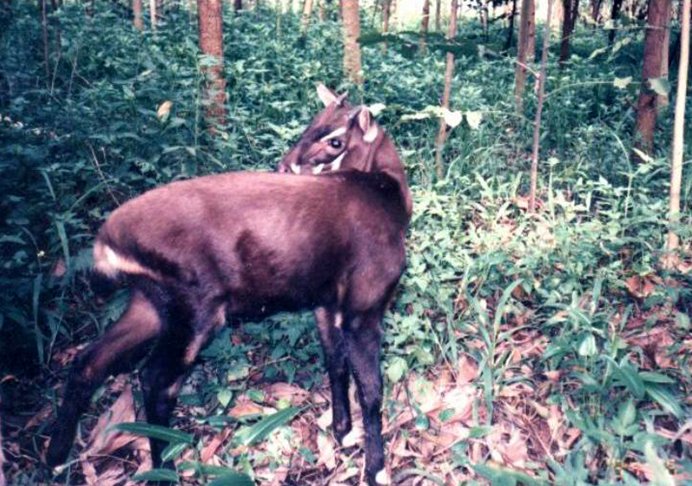|
| Query: Vu quang ox | Result: 1st of 8 | |
Saola, Vu Quang Ox (Pseudoryx nghetinhensis) - Wiki
| Subject: | Saola, Vu Quang Ox (Pseudoryx nghetinhensis) - Wiki
| |

| Resolution: 692x486
File Size: 105046 Bytes
Upload Date: 2007:10:16 22:06:44
|
Saola
From Wikipedia, the free encyclopedia
[Photo] Saola, Vu Quang Ox (Pseudoryx nghetinhensis). vi:Th??? lo???i:S??ch đ??? Vi???t Nam
Source: http://vi.wikipedia.org/wiki/H%C3%ACnh:Pseudoryx_nghetinhensis.PNG Date 2007-02-02 (original upload date). Author Original uploader was Silviculture (http://vi.wikipedia.org/wiki/User:Silviculture) | Permission is granted to copy, distribute and/or modify this document under the terms of the GNU Free Documentation License, Version 1.2 or any later version published by the Free Software Foundation; with no Invariant Sections, no Front-Cover Texts, and no Back-Cover Texts. A copy of the license is included in the section entitled "GNU Free Documentation License". |
The Saola or Vu Quang ox, also, infrequently, Vu Quang bovid (Pseudoryx nghetinhensis), one of the world's rarest mammals, is a forest-dwelling bovine found only in Vietnam (Vu Quang Nature Reserve) and in Laos, near the Vietnam-Laotian border. Its name Saola means spindle-[horned]. The scientific epithet nghetinhensis refers to the two Vietnamese provinces of Nghe An and Ha Tinh while Pseudoryx acknowledges the animal's similarities with the Arabian or African oryx. The Hmong natives call this beast saht-supahp, a term derived from Lao meaning "the polite animal", because it moves quietly through the forest.
Saolas have only been known to zoologists since 1992, from several pairs of unusual horns obtained in Vietnam. Chromosomic analysis has since revealed that this is a new ruminant genus, related to cows, anoas, kudus or elands. It is still uncertain whether they are cattle, antelope or goats. It is not known how many of this species exist, as only 11 have been recorded alive.
They can occasionally be viewed at General Cheng's zoo in Lak Xao, Laos.
Habitat and distribution
The saola occurs in the Annamite Range's moist forests and the Eastern Indochina dry and monsoon forests. They have been spotted in steep river valleys at about 300 to 1800 m above sea level. These regions are distant from human settlements, covered primarily in evergreen or mixed evergreen and deciduous woodlands. The species seems to prefer edge zones of the forests.
Saolas stay in mountain forests during the wet seasons, when water in streams and rivers is abundant, and move down to the lowlands in winter. They are shy and never enter cultivated fields or come close to villages. To date, all known captive saolas have died, leading to the belief that this species cannot live in captivity.
Description
The saola stands about 85 cm at the shoulder and weighs approximately 90 kg. The coat is a dark brown with a black stripe along the back. Its legs are darkish and there are white patches on the feet, and white stripes vertically across the cheeks, on the eyebrows and splotches on the nose and chin. All saolas have slightly backward-curved horns, which grow to half a metre in length.
Local populations report having seen saolas traveling in packs of two or three, rarely more.
Saola mark their territories by opening up a fleshy flap on their snout to reveal scent glands. They subsequently rub the underside against objects leaving a musky, pungent paste. The saolas' colossal scent glands are thought to be the largest of any living mammal.
Diet
They are reported to eat small leafy plants???especially fig leaves, and stems along rivers. Saolas generally live in small groups of less than five animals. The animal seems to have a browsing diet, considering its small incisors.
Threat
The major threat is hunting???the species' meat being highly appreciated by local people???and degradation of its forest habitats in the region.
http://en.wikipedia.org/wiki/Saola
| The text in this page is based on the copyrighted Wikipedia article shown in above URL. It is used under the GNU Free Documentation License. You may redistribute it, verbatim or modified, providing that you comply with the terms of the GFDL. |
|
^o^
Animal Pictures Archive for smart phones
^o^
|
|